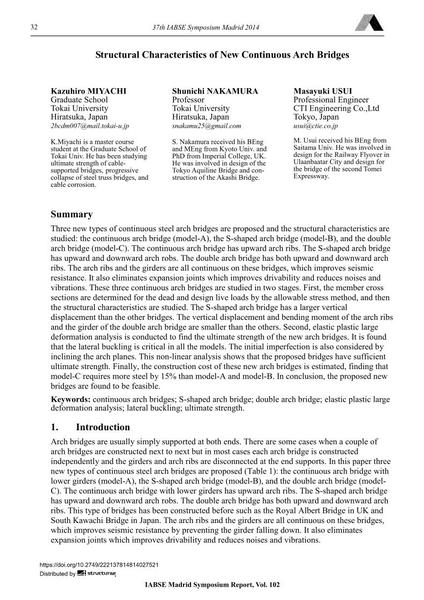Structural Characteristics of New Continuous Arch Bridges

|
|
|||||||||||
Détails bibliographiques
| Auteur(s): |
Kazuhiro Miyachi
Shunichi Nakamura Masayuki Usui |
||||
|---|---|---|---|---|---|
| Médium: | papier de conférence | ||||
| Langue(s): | anglais | ||||
| Conférence: | IABSE Symposium: Engineering for Progress, Nature and People, Madrid, Spain, 3-5 September 2014 | ||||
| Publié dans: | IABSE Symposium Madrid 2014 | ||||
|
|||||
| Page(s): | 32-39 | ||||
| Nombre total de pages (du PDF): | 8 | ||||
| Année: | 2014 | ||||
| DOI: | 10.2749/222137814814027521 | ||||
| Abstrait: |
Three new types of continuous steel arch bridges are proposed and the structural characteristics are studied: the continuous arch bridge (model-A), the S-shaped arch bridge (model-B), and the double arch bridge (model-C). The continuous arch bridge has upward arch ribs. The S-shaped arch bridge has upward and downward arch robs. The double arch bridge has both upward and downward arch ribs. The arch ribs and the girders are all continuous on these bridges, which improves seismic resistance. It also eliminates expansion joints which improves drivability and reduces noises and vibrations. These three continuous arch bridges are studied in two stages. First, the member cross sections are determined for the dead and design live loads by the allowable stress method, and then the structural characteristics are studied. The S-shaped arch bridge has a larger vertical displacement than the other bridges. The vertical displacement and bending moment of the arch ribs and the girder of the double arch bridge are smaller than the others. Second, elastic plastic large deformation analysis is conducted to find the ultimate strength of the new arch bridges. It is found that the lateral buckling is critical in all the models. The initial imperfection is also considered by inclining the arch planes. This non-linear analysis shows that the proposed bridges have sufficient ultimate strength. Finally, the construction cost of these new arch bridges is estimated, finding that model-C requires more steel by 15% than model-A and model-B. In conclusion, the proposed new bridges are found to be feasible. |
||||
